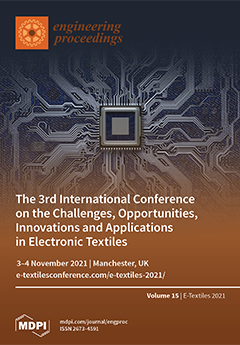Eng. Proc., 2022, E-Textiles 2021
The 3rd International Conference on the Challenges, Opportunities, Innovations and Applications in Electronic Textiles
Manchester, UK | 3–4 November 2021
Volume Editors:
Steve Beeby, University of Southampton, UK
Kai Yang, University of Southampton, UK
Russel Torah, University of Southampton, UK
Printed Edition Available!
- Issues are regarded as officially published after their release is announced to the table of contents alert mailing list.
- You may sign up for e-mail alerts to receive table of contents of newly released issues.
- PDF is the official format for papers published in both, html and pdf forms. To view the papers in pdf format, click on the "PDF Full-text" link, and use the free Adobe Reader to open them.




